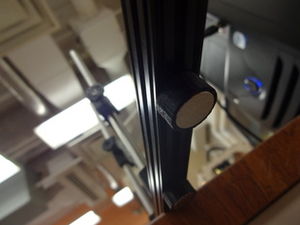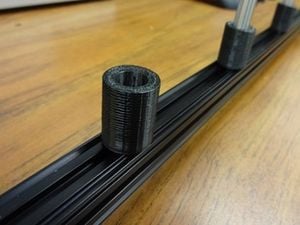
This project is part of a collection on open source optics meant to radically reduce the cost of experimental optical equipment. See: Zhang C, Anzalone NC, Faria RP, Pearce JM (2013) Open-Source 3D-Printable Optics Equipment. PLoS ONE 8(3): e59840. doi:10.1371/journal.pone.0059840 open access
This is part of a system of prints that turns an OpenBeam into an optical rail. An optical rail is a long, straight, sturdy rail onto which optical components such as light sources and lenses can be bolted down and easily shifted along the length of the rail.
Commercial optical rail sells for $380/m ($115/ft). OpenBeam only costs $12/m for the best black anodized rail. It is also far easier to customize - or reuse for something else when you are done with your optics experiment.

You will need an m3 screw and nut along with the magnet. Put the screw through the base and screw onto the OpenBeam with an m3 nut. Then press fit the magnet on top of it. We have all these old steel desks that work as great bases. The simple rod holder works the same way -- these are for optical components that will have a relatively permanent location.
If you do not have a metal base to put your open-source optical rail on you can just as easily make and OpenBeam into an optical rail by screwing on two printable T-brackets
- ---
Next you will want to add some mounts -- see:
You can get OpenBeam here To get the magnets see [1]
Source files[edit | edit source]
For full 3D printing details and OpenSCAD files see:

